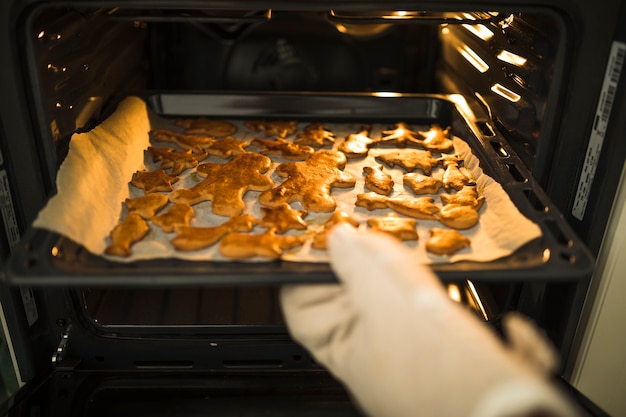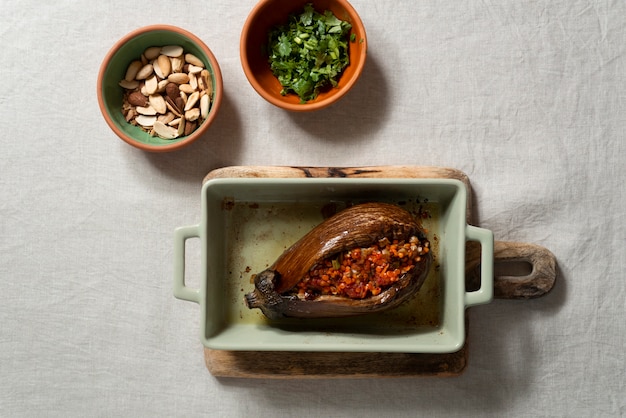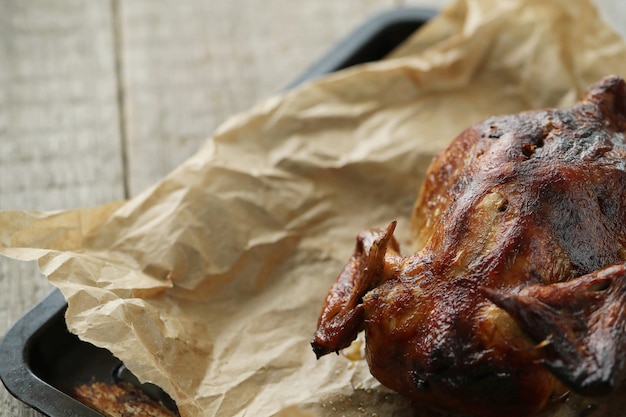There's a certain magic in sinking your teeth into a perfectly cooked rack of ribs, the meat melting in your mouth, bathed in a sticky, flavorful sauce. As a seasoned home cook who's always on the lookout for new culinary adventures, I've spent a fair amount of time perfecting my rib-making skills. And let me tell you, oven-baked ribs are a revelation. They're incredibly easy to make, and the results are consistently fantastic, even surpassing those from the grill on some days!
In this guide, we're going to dive headfirst into the world of oven-baked spare ribs, exploring every step from choosing the right cut to creating that irresistible, melt-in-your-mouth tenderness. Get ready to elevate your barbecue game and impress your friends and family with ribs that will have them begging for seconds – and maybe even thirds!
(Part 1) Choosing the Right Cut

Let's face it, the foundation of a truly delicious rib experience begins with choosing the right cut. While baby back ribs might be the star of the show, spare ribs offer a unique flavor profile and are often a more budget-friendly option. And trust me, once you've experienced the magic of oven-baked spare ribs, you'll be a convert.
Why Spare Ribs Are My Go-To
Spare ribs, often called "St. Louis-style" ribs after the trimming process, are the ribs that come from the lower part of the pig's rib cage. They tend to be a little larger than baby back ribs, offering more meat and a more robust flavor. The meaty texture is something I truly appreciate. You get a satisfying bite with each piece, and there's a good deal of surface area for that delicious barbecue sauce to cling to.
Now, let's talk about trimming. It's a crucial step to ensure a great rib experience. Here's my approach:
Trimming for Perfection
When I'm at the butcher's, I always ask them to trim the membrane off the back of the ribs. This membrane, called the "silver skin," is tough and can prevent the ribs from becoming as tender as they should be. It's a bit of a chore to remove, so letting the butcher handle it saves me some time. But if you're keen on doing it yourself, grab a sharp knife and carefully pull the membrane away from the ribs. It can be a little tricky, but it's worth the effort for those melt-in-your-mouth results.
(Part 2) The Art of Seasoning

Seasoning is where your creative culinary journey truly begins. While a simple rub is perfectly fine, I like to experiment with different flavor profiles. Here's a basic recipe that I often use, but feel free to get creative and add your own twists!
My Go-To dry rub Recipe
For a classic, smoky flavor, I combine:
- 2 tablespoons paprika – This adds a beautiful color and a slightly smoky flavor.
- 1 tablespoon brown sugar – Just a touch of sweetness to balance out the savory flavors.
- 1 tablespoon garlic powder – Adds a depth of flavor and aroma.
- 1 tablespoon onion powder – Adds a savory depth, complementing the garlic powder perfectly.
- 1 teaspoon salt – Essential for seasoning and enhancing the flavor of the meat.
- 1 teaspoon black pepper – Adds a touch of heat and complexity to the flavor profile.
- 1 teaspoon dried thyme – Adds a subtle earthiness that works beautifully with ribs.
- 1 teaspoon chili powder (optional, for a kick!) – If you prefer a bit of heat, chili powder adds a welcome kick. Adjust the amount to your taste.
Mix it all together and generously rub it all over the ribs. You can even add a little bit of olive oil to help the seasoning stick. It’s important to coat them evenly, making sure to get into all the nooks and crannies. This will ensure that your ribs are beautifully seasoned and caramelized during the cooking process.
After seasoning, I like to let the ribs sit in the fridge for at least a couple of hours, preferably overnight. This allows the flavors to really penetrate the meat. Just make sure to cover them tightly in plastic wrap to prevent them from drying out.
(Part 3) Pre-Cooking for Tenderness

For those fall-off-the-bone ribs, pre-cooking is key. This technique helps break down the connective tissues and ensures those ribs are perfectly tender. It's the secret to achieving the ultimate rib experience. Here's what I do:
The Power of Pre-Cooking
I typically use the "low and slow" method for pre-cooking, which involves cooking the ribs in a low oven at a temperature around 250°F (120°C) for a few hours. It's a gentle process that allows the meat to cook evenly and become incredibly tender. I find that a good 3-4 hours is ideal, but if you have more time, you can always go longer for even more incredible results. The longer you cook, the more tender they'll become.
Here's a simple technique:
My Pre-Cooking Method
1. Preheat your oven to 250°F (120°C). A low temperature allows the meat to cook slowly and gently, breaking down the tough connective tissues and creating melt-in-your-mouth tenderness.
2. Place the ribs in a roasting pan, bone-side down. This helps to ensure even cooking and helps the ribs retain moisture.
3. Add about 1 cup of water to the bottom of the pan. This creates steam and helps prevent the ribs from drying out. The steam gently cooks the ribs, making them exceptionally moist and tender.
4. Cover the pan tightly with aluminium foil. This creates a sealed environment that traps the steam and helps the ribs cook evenly.
5. Cook for 3-4 hours, or until the meat is very tender. You can check for doneness by gently pulling on a bone. If the meat pulls away easily from the bone, they're ready for the next stage.
The ribs are ready for the next stage when the meat is tender enough to pull apart easily with a fork. This means the connective tissues have broken down, resulting in ribs that are fall-off-the-bone tender.
(Part 4) Glazing for That Extra Wow Factor
Once those ribs are pre-cooked, it's time for the finishing touch - the glaze! I find that a good glaze not only adds an incredible layer of flavor but also creates that mouthwatering, sticky finish that everyone loves.
My Glaze Recipe
I like to make my own glaze, but you can definitely use store-bought options. Here’s a basic glaze recipe you can adapt:
- 1 cup ketchup – The foundation of the glaze, adding sweetness and a tangy flavor.
- 1/2 cup brown sugar – Adds a touch of sweetness that balances the tangy ketchup and vinegar.
- 1/4 cup apple cider vinegar – Adds a touch of acidity that cuts through the sweetness and enhances the overall flavor profile.
- 1 tablespoon Worcestershire sauce – Adds a complex umami flavor and a touch of savoriness.
- 1 teaspoon garlic powder – Adds a savory depth and aroma, complementing the other flavors.
- 1 teaspoon onion powder – Adds a savory depth, complementing the garlic powder perfectly.
- 1/2 teaspoon black pepper – Adds a touch of heat and complexity, rounding out the glaze.
Mix all the ingredients together in a saucepan and bring to a simmer. Cook for about 5 minutes, stirring occasionally, until the glaze thickens. You can adjust the sweetness and tanginess of the glaze to your preference by adding more sugar or vinegar.
Glazing Technique
1. Preheat your oven to 350°F (180°C). This temperature is ideal for caramelizing the glaze and giving it that beautiful, glossy finish.
2. Remove the ribs from the oven and carefully remove the aluminium foil. Allow the ribs to cool slightly before proceeding.
3. Brush the ribs generously with the glaze. Don't be shy, the more glaze, the better! It will create a sticky, flavorful coating that enhances the flavor and adds a beautiful caramelized finish.
4. Return the ribs to the oven and cook for another 30-45 minutes, or until the glaze is bubbly and caramelized. You'll know they're ready when the glaze is bubbling and has reached a deep, caramelized color.
5. The ribs are ready to serve! Let them rest for a few minutes before cutting and serving. This allows the juices to redistribute, resulting in juicy, flavorful ribs.
During those final cooking minutes, the glaze will caramelize and create a beautiful, glossy finish. You’ll be able to smell the delicious aromas filling your kitchen, and I can guarantee you'll be ready to dig in!
(Part 5) The Final Touch: Serving Your Ribs
You've put in the work, and now it's time to reap the rewards. Here’s my guide to serving those perfect oven-baked ribs:
Time to Feast
Remove those magnificent ribs from the oven and let them rest for about 10 minutes before cutting and serving. This allows the juices to redistribute, ensuring each bite is juicy and flavorful.
side dishes for the Perfect Rib Experience
I love to pair my ribs with a variety of sides, Here are some of my favorites:
- Creamy Coleslaw: A classic and refreshing side that complements the richness of the ribs. The tanginess of the coleslaw cuts through the richness of the ribs, creating a delicious balance of flavors.
- Baked Beans: A staple for any barbecue feast. They add a touch of sweetness and a smoky flavor that complements the ribs perfectly.
- Mac and Cheese: A cheesy, comforting side that everyone loves. It's the perfect companion to the ribs, adding a rich and creamy element to the meal.
- Cornbread: A Southern classic that adds a sweet and crumbly element to your meal. The sweetness of the cornbread contrasts beautifully with the savory flavor of the ribs.
- potato salad: A versatile side that can be dressed up or down depending on your preferences. It's a refreshing and flavorful side that adds a touch of elegance to the meal.
Presentation Matters!
Even though these ribs are delicious, presentation matters. I like to cut the ribs into individual portions and arrange them on a platter with a generous dollop of glaze. For a touch of elegance, you can garnish with fresh herbs like parsley or chives. It's all about creating a visually appealing and delicious experience.
(Part 6) Tips for Success
Over the years, I've learned a few tricks that help ensure perfect ribs every time. Here are some tips to elevate your oven-baked rib game:
1. The Right Oven Temperature is Key
Preheat your oven to the correct temperature for pre-cooking and the final glaze. This ensures even cooking and prevents the ribs from drying out. A consistent oven temperature is essential for achieving that perfect balance of tenderness and flavor.
2. Don't Overcook!
Ribs are best when they're cooked to tender perfection. Overcooking can lead to dryness and toughness. Use a meat thermometer to check the internal temperature. The ribs are done when they reach an internal temperature of 190°F (88°C). This ensures that the ribs are cooked through and tender without being overcooked.
3. Don't Be Afraid to Experiment with Flavors
Feel free to experiment with different dry rubs, glazes, and even marinades. Get creative with your spices and add your own personal touch. There are no limits to what you can create! This is where your culinary creativity truly shines. Don't be afraid to try new things and discover your own signature rib flavor.
4. Rest Before Serving
After removing the ribs from the oven, let them rest for about 10 minutes before serving. This allows the juices to redistribute, resulting in juicy, flavorful ribs.
(Part 7) FAQs
Here are some common questions about oven-baked spare ribs:
1. What if my ribs are too dry?
If your ribs are too dry, it's likely that they were overcooked. Next time, try cooking them at a lower temperature for a longer period of time. You can also add a bit of liquid to the bottom of the roasting pan to create steam. This will help prevent the ribs from drying out.
2. How can I make my ribs even more flavorful?
Experiment with different dry rubs, glazes, and even marinades. You can also try adding a few tablespoons of apple cider vinegar to the bottom of the roasting pan for a tangy flavor.
3. Can I make these ribs ahead of time?
Absolutely! You can pre-cook the ribs up to a day in advance and store them in the refrigerator. When you're ready to serve, simply reheat them in the oven or on the grill. Just be sure to reheat them slowly to avoid drying them out.
4. Is it okay to use a store-bought glaze?
Definitely! If you're short on time or just don't feel like making your own glaze, there are plenty of great store-bought options available. Just make sure to choose a glaze that you like the flavor of.
5. What if I don't have a meat thermometer?
You can check the doneness of your ribs by gently pulling on a bone. If the meat pulls away easily from the bone, they are done. You can also use a fork to gently probe the meat. If the meat feels tender and easily pulls apart, it's ready to serve.
(Part 8) Conclusion
Oven-baked spare ribs are a truly rewarding culinary adventure, and with a little practice, you'll become a rib master in no time! Remember, don't be afraid to experiment and let your creativity shine. With the right techniques and a little patience, you'll be able to create ribs that are tender, flavorful, and guaranteed to impress. So, gather your ingredients, get your oven ready, and let's get cooking!
Everyone is watching

Prime Rib Roast Cooking Time Chart: Per Pound Guide
Cooking TipsPrime rib roast. Just the name conjures images of lavish dinners, crackling fires, and hearty laughter. It’s ...

How Long to Bake Potatoes in the Oven (Perfect Every Time)
Cooking TipsBaked potatoes are a staple in my kitchen. They're incredibly versatile, delicious, and surprisingly easy to m...

Perfect Rice Every Time: The Ultimate Guide to Cooking Rice
Cooking TipsAs a self-proclaimed foodie, I've always been a bit obsessed with rice. It's the foundation of countless cuisi...

The Ultimate Guide to Cooking Asparagus: Tips, Techniques, and Recipes
Cooking TipsAsparagus. The mere mention of this spring delicacy conjures up images of vibrant green spears, crisp and burs...

Ultimate Guide to Cooking the Perfect Thanksgiving Turkey
Cooking TipsThanksgiving. Just the word conjures up images of overflowing tables laden with delicious food, the scent of r...
